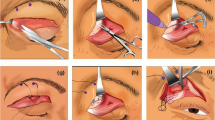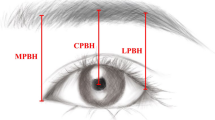Abstract
Background
In his facial aesthetics practice, the senior author (B.G.) observed that many patients presenting with horizontal forehead lines also demonstrated upper eyelid ptosis or enough blepharodermachalasia to require compensation. This study was conducted to investigate this observation.
Methods
Photographs of patients presenting for facial rejuvenation were retrospectively reviewed for the presence of forehead lines, ptosis, brow ptosis, and blepharodermatochalasia. Patient age, gender, and race were reported. Only patients over age 50 were included. Patients who had previous eyelid or forehead surgery, congenital abnormalities, or post-traumatic deformities were excluded. Ptosis was defined as more than 1.5-mm overlap between the upper eyelid and the iris. Patients were divided into two groups based on presence of forehead lines for comparative analysis.
Results
One hundred sixty patients, including 100 patients with and 60 patients without horizontal forehead lines, were included. Patients with forehead lines were likely to be older (age 61.56 ± 8.93 vs. 58.58 ± 7.59; P = 0.0337), male (36 vs. 11.67%; P = 0.0008), have ptosis (90 vs. 76.67%; P = 0.0377), and have blepharodermatochalasis (20 vs. 5%; P = 0.0097). All 28 patients with unilateral forehead lines (17 left, 11 right) had ipsilateral ptosis.
Conclusions
Ptosis and blepharodermatochalasis may result in the development of horizontal forehead lines through compensatory frontalis activation. Whenever horizontal forehead rhytids are noted, it is imperative to search for ptosis or blepharodermachalasia in repose. Otherwise, forehead rejuvenation may fail to eliminate these compensatory forehead lines, and chemodenervation may have significant adverse effects on the visual field by forcibly blocking frontalis compensation.
Level of Evidence III
This journal requires that authors assign a level of evidence to each article. For a full description of these Evidence-Based Medicine ratings, please refer to the Table of Contents or the online Instructions to Authors www.springer.com/00266.



Similar content being viewed by others
References
Lam VB, Czyz CN, Wulc AE (2013) The brow-eyelid continuum. Clin Plast Surg 40:1–19. https://doi.org/10.1016/j.cps.2012.06.001
Karacalar A, Korkmaz A, Kale A, Kopuz C (2005) Compensatory brow asymmetry: anatomic study and clinical experience. Aesthet Plast Surg 29:119–123. https://doi.org/10.1007/s00266-004-0086-5
Fagien S (1992) Eyebrow analysis after blepharoplasty in patients with brow ptosis. Ophthal Plast Reconstr Surg 8:210–214
Huijing MA, van der Palen J, van der Lei B (2014) The effect of upper eyelid blepharoplasty on eyebrow position. J Plast Reconstr Aesthet Surg 67:1242–1247. https://doi.org/10.1016/j.bjps.2014.05.022
Kim D, Son D, Kim M et al (2015) Does upper blepharoplasty affect frontalis tonicity? J Plast Reconstr Aesthet Surg 68:638–644. https://doi.org/10.1016/j.bjps.2015.01.012
Lew H, Goldberg RA (2016) Maximizing symmetry in upper blepharoplasty. Plast Reconstr Surg 137:296e–304e. https://doi.org/10.1097/01.prs.0000475751.48462.b7
Karacalar A, Korkmaz A, Kale A, Kopuz C (2005) Compensatory brow asymmetry: anatomic study and clinical experience. Aesthet Plast Surg 29:119–123. https://doi.org/10.1007/s00266-004-0086-5
Ezure T, Amano S (2010) The severity of wrinkling at the forehead is related to the degree of ptosis of the upper eyelid. Skin Res Technol 16:202–209. https://doi.org/10.1111/j.1600-0846.2010.00427.x
Rossi AM, Eviatar J, Green JB et al (2017) Signs of facial aging in men in a diverse, multinational study. Dermatol Surg 43:S210–S220. https://doi.org/10.1097/DSS.0000000000001293
Shah CT, Nguyen EV, Hassan AS (2012) Asymmetric eyebrow elevation and its association with ocular dominance. Ophthalmic Plast Reconstr Surg 28:50–53. https://doi.org/10.1097/IOP.0b013e3182364aea
Author information
Authors and Affiliations
Corresponding author
Ethics declarations
Conflict of interest
None of the authors have a financial interest in any of the products, devices, or drugs mentioned in this manuscript.
Rights and permissions
About this article
Cite this article
Wu-Fienberg, Y., Bafna, K.R. & Guyuron, B. Horizontal Forehead Lines: A Reflection of Eyelid Ptosis or Blepharodermachalasia. Aesth Plast Surg 42, 1551–1555 (2018). https://doi.org/10.1007/s00266-018-1198-7
Received:
Accepted:
Published:
Issue Date:
DOI: https://doi.org/10.1007/s00266-018-1198-7




